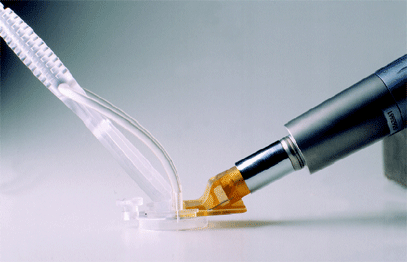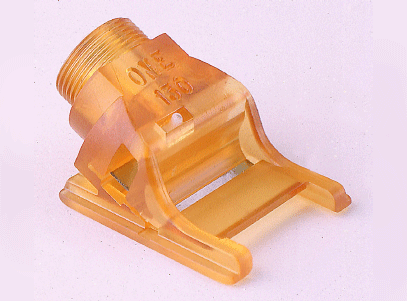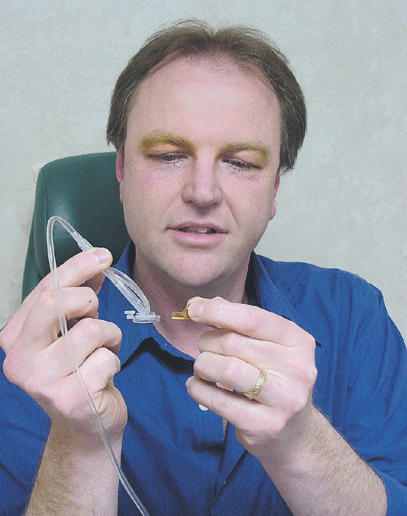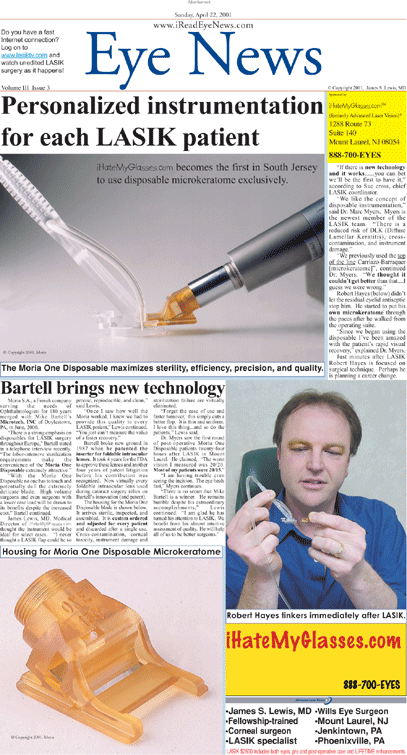Philadelphia / Bucks County LASIK Surgeon – Dr. James S. Lewis
Eye News Volume III Issue 3

Personalized instrumentation for each
LASIK patient
LASIK patient

The Moria One Disposable maximizes sterility,
efficiency, precision, and quality.
efficiency, precision, and quality.
Bartell brings surgeons new technology
Moria S.A., a French company serving the needs of Ophthalmologists for 180 years merged with Mike Bartell’s Microtech, INC of Doylestown, PA, in June, 2000.
“There is a strong emphasis on disposables for LASIK surgery throughout Europe,” Bartell stated in a telephone interview recently. “The labor-intensive sterilization requirements make the convenience of the Moria One Disposable extremely attractive.”
“With the Moria One Disposable no one has to touch and potentially dull the extremely delicate blade. High volume surgeons and even surgeons with a lower case load will be drawn to its benefits despite the increased cost,” Bartell continued.
James Lewis, MD, Medical Director of iHateMyGlasses.com thought the instrument would be ideal for select cases. “I never thought a LASIK flap could be so precise, reproducible, and clean,” said Lewis.
“Once I saw how well the Moria worked, I knew we had to provide this quality to every LASIK patient,” Lewis continued. “You just can’t measure the value of a faster recovery.”
Bartell broke new ground in 1987 when he patented the inserter for foldable intraocular lenses. It took 4 years for the FDA to approve these lenses and another four years of patent litigation before his contribution was recognized. Now virtually every foldable intraocular lens used during cataract surgery relies on Bartell’s innovation (and patent).
The housing for the Moria One Disposable blade is shown below. It arrives sterile, inspected, and assembled. It is custom ordered and adjusted for every patient and discarded after a single use. Cross-contamination, corneal toxicity, instrument damage and sterilization failure are virtually eliminated.
“Forget the ease of use and faster turnover, this simply cuts a better flap. It is thin and uniform. I love this thing…and so do the patients,” Lewis said.
Dr. Myers saw the first round of post-operative Moria One Disposable patients twenty-four hours after LASIK in Mount Laurel. He claimed, “The worst vision I measured was 20/20. Most of my patients were 20/15.”
“I am having trouble even seeing the incision. The eye heals fast,” Myers continues.
“There is no secret that Mike Bartell is a winner. He remains humble despite his extraordinary accomplishments,” Lewis continued. “I am glad he has turned his attention to LASIK. We benefit from his almost intuitive assessment of quality. He will help all of us to be better surgeons.”
“There is a strong emphasis on disposables for LASIK surgery throughout Europe,” Bartell stated in a telephone interview recently. “The labor-intensive sterilization requirements make the convenience of the Moria One Disposable extremely attractive.”
“With the Moria One Disposable no one has to touch and potentially dull the extremely delicate blade. High volume surgeons and even surgeons with a lower case load will be drawn to its benefits despite the increased cost,” Bartell continued.
James Lewis, MD, Medical Director of iHateMyGlasses.com thought the instrument would be ideal for select cases. “I never thought a LASIK flap could be so precise, reproducible, and clean,” said Lewis.
“Once I saw how well the Moria worked, I knew we had to provide this quality to every LASIK patient,” Lewis continued. “You just can’t measure the value of a faster recovery.”
Bartell broke new ground in 1987 when he patented the inserter for foldable intraocular lenses. It took 4 years for the FDA to approve these lenses and another four years of patent litigation before his contribution was recognized. Now virtually every foldable intraocular lens used during cataract surgery relies on Bartell’s innovation (and patent).
The housing for the Moria One Disposable blade is shown below. It arrives sterile, inspected, and assembled. It is custom ordered and adjusted for every patient and discarded after a single use. Cross-contamination, corneal toxicity, instrument damage and sterilization failure are virtually eliminated.
“Forget the ease of use and faster turnover, this simply cuts a better flap. It is thin and uniform. I love this thing…and so do the patients,” Lewis said.
Dr. Myers saw the first round of post-operative Moria One Disposable patients twenty-four hours after LASIK in Mount Laurel. He claimed, “The worst vision I measured was 20/20. Most of my patients were 20/15.”
“I am having trouble even seeing the incision. The eye heals fast,” Myers continues.
“There is no secret that Mike Bartell is a winner. He remains humble despite his extraordinary accomplishments,” Lewis continued. “I am glad he has turned his attention to LASIK. We benefit from his almost intuitive assessment of quality. He will help all of us to be better surgeons.”

Housing for Moria One Disposable Microkeratome
© Copyright Moria, INC.
“If there is new technology and it works……you can bet we’ll be the first to have it,” according to Sue cross, chief LASIK coordinator.
“We like the concept of disposable instrumentation,” said Dr. Marc Myers. Myers is the newest member of the LASIK team. “There is a reduced risk of DLK (Diffuse Lamellar Keratitis), cross-contamination, and instrument damage.”
“We previously used the top of the line Carriazo-Barraquer [microkeratome]”, continued Dr. Myers. “We thought it couldn’t get better than that….I guess we were wrong.”
Robert Hayes (below) didn’t let the residual eyelid antiseptic stop him. He started to put his own microkeratome through the paces after he walked from the operating suite.
“Since we began using the disposable I’ve been amazed with the patient’s rapid visual recovery,” explained Dr. Myers.
Just minutes after LASIK Robert Hayes is focused on surgical technique. Perhaps he is planning a career change.
“We like the concept of disposable instrumentation,” said Dr. Marc Myers. Myers is the newest member of the LASIK team. “There is a reduced risk of DLK (Diffuse Lamellar Keratitis), cross-contamination, and instrument damage.”
“We previously used the top of the line Carriazo-Barraquer [microkeratome]”, continued Dr. Myers. “We thought it couldn’t get better than that….I guess we were wrong.”
Robert Hayes (below) didn’t let the residual eyelid antiseptic stop him. He started to put his own microkeratome through the paces after he walked from the operating suite.
“Since we began using the disposable I’ve been amazed with the patient’s rapid visual recovery,” explained Dr. Myers.
Just minutes after LASIK Robert Hayes is focused on surgical technique. Perhaps he is planning a career change.

Robert Hayes tinkers immediately after LASIK.

At Dr. Lewis’ state-of-the-art laser eye surgery Bucks County / Philadelphia offices, patients are treated with the utmost respect and attentiveness. In addition to performing LASIK and Epi-LASIK, Dr. Lewis specializes in treating Philadelphia / Bucks County ICLs patients. Please visit the respective procedure pages to learn more about these exciting, highly effective vision correction treatments.